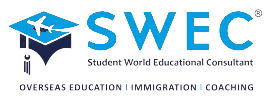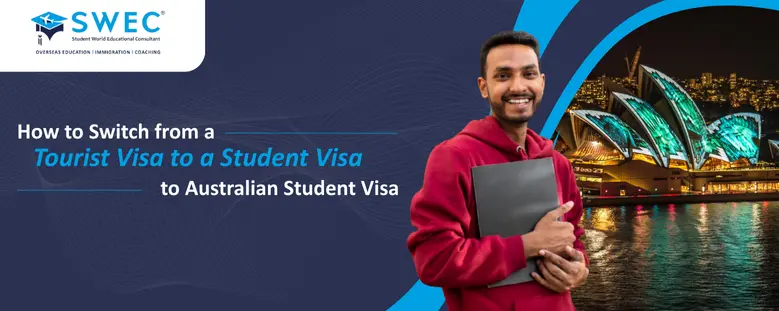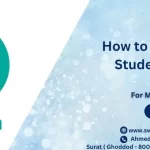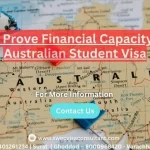Australia is one of the most popular destinations for international students, offering world-class education, diverse career opportunities, and a high quality of life. Many visitors who arrive in Australia on a tourist visa often decide to extend their stay by enrolling in an educational course. This shift is commonly driven by the country’s excellent universities, vocational training programs, and the opportunity to work while studying.
However, switching from a Tourist Visa (Subclass 600) to a Student Visa (Subclass 500) requires careful planning and compliance with Australian immigration laws. It is essential to follow the correct procedures to avoid legal complications or visa rejections.
This is where SWEC plays a crucial role. With years of experience in student visa processing, SWEC provides expert guidance, ensuring a smooth transition from a tourist visa to a student visa in Australia.
Understanding the Difference: Tourist Visa vs. Student Visa
Before starting the process of converting a tourist visa to a student visa, it is important to understand the key differences between the two visa types.
Tourist Visa (Subclass 600)
The Tourist Visa (Subclass 600) is issued primarily for short-term visits to Australia, such as sightseeing, visiting family and friends, or attending short-term courses (less than three months).
Key Limitations of a Tourist Visa:
- Usually allows a stay of up to 3, 6, or 12 months.
- Does not permit long-term studies beyond three months.
- Does not provide work rights in Australia.
- May include the 8503 No Further Stay condition, restricting visa extensions or changes.
Student Visa (Subclass 500)
The Student Visa (Subclass 500) is designed for international students enrolling in full-time education programs at CRICOS-registered institutions in Australia.
Benefits of a Student Visa:
- Allows students to study full-time at a recognized Australian educational institution.
- Provides part-time work rights (48 hours per fortnight during term and unlimited hours during holidays).
- Enables students to stay in Australia for the entire duration of their course.
- Offers eligibility for subsequent visa options such as Post-Study Work Visa (Subclass 485).
- Allows dependent family members (spouse and children) to accompany the student.
Key Requirements for a Student Visa:
- Confirmation of Enrollment (CoE) from an Australian educational institution.
- Proof of sufficient funds to cover tuition fees, living expenses, and return travel.
- English language proficiency (IELTS, PTE, TOEFL, or equivalent test scores).
- Overseas Student Health Cover (OSHC) for medical insurance.
- A valid Genuine Temporary Entrant (GTE) statement to prove that the applicant’s primary intention is to study.
Can You Convert a Tourist Visa to a Student Visa in Australia?
Yes, it is legally possible to apply for a student visa while in Australia on a tourist visa. However, there are specific conditions and requirements to be met.
Conditions & Restrictions for Visa Conversion
1. 8503 No Further Stay Condition
Some tourist visas come with the 8503 No Further Stay condition, which prohibits applying for another visa while in Australia. However, you can request a waiver of this condition under special circumstances.
How to Request a Waiver of 8503 Condition:
- You must prove exceptional and compelling circumstances that have arisen since the grant of the tourist visa.
- Submit a formal waiver request through ImmiAccount, along with supporting documents.
- If the waiver is approved, you may proceed with your student visa application.
2. Meeting Student Visa Eligibility Requirements
- Ensure you have a valid CoE (Confirmation of Enrollment) from a CRICOS-registered institution.
- Meet financial capacity requirements to cover tuition, living expenses, and travel costs.
- Demonstrate English language proficiency through IELTS, PTE, or TOEFL.
- Obtain Overseas Student Health Cover (OSHC) before applying.
Benefits of Switching to a Student Visa Within Australia
Instead of returning to your home country and applying for a student visa from there, switching from a tourist visa to a student visa within Australia has several advantages:
1. Faster Processing Time
Applying within Australia often leads to quicker processing times compared to offshore applications.
2. Avoids Travel Costs & Delays
You can stay in Australia legally while waiting for your student visa decision, saving money on international travel.
3. Possible Bridging Visa Grant
Once you apply for a student visa from within Australia, you may be eligible for a Bridging Visa (BVA), which allows you to remain in Australia while your application is processed.
4. Smooth Transition to Student Life
You can start adjusting to the Australian education system, explore part-time work opportunities, and settle into the local culture without interruption.
Step-by-Step Guide to Switching from a Tourist Visa to a Student Visa in Australia
If you are in Australia on a Tourist Visa (Subclass 600) and wish to continue your stay as an international student, you must transition to a Student Visa (Subclass 500). This process involves several important steps, and it is crucial to follow the correct procedure to ensure a smooth transition.
Below is a detailed step-by-step guide to help you understand and complete the process successfully.
Step 1: Choose a Course and Institution
Before applying for a student visa, you must enroll in a course at a CRICOS-registered institution.
Why is CRICOS Registration Important?
The Commonwealth Register of Institutions and Courses for Overseas Students (CRICOS) ensures that institutions meet the quality standards required for international students. If an institution is not CRICOS-registered, its courses will not be eligible for a student visa application.
How to Find the Right Course?
- Choose a course that aligns with your career goals and educational background.
- Ensure the institution has good reviews and strong student support services.
- Consider course duration, tuition fees, and location.
How SWEC Can Help
SWEC (Study World Education Consultancy) has partnerships with top CRICOS-registered universities and colleges in Australia. Our experts help you select the best course based on your interests and career plans.
Step 2: Apply for Admission & Receive Confirmation of Enrollment (CoE)
Once you have chosen your course and institution, you need to apply for admission.
Application Requirements:
- Academic Transcripts: Previous qualifications (high school, undergraduate, or postgraduate degrees).
- English Language Proficiency: IELTS, PTE, TOEFL, or equivalent test scores.
- Work Experience (if applicable): Some courses require relevant work experience.
- Statement of Purpose (SOP): A letter explaining your study goals and reasons for choosing Australia.
Timeline for Application Processing
Admission processing usually takes 2 to 6 weeks, depending on the institution and course. Once your application is accepted, you will receive a Letter of Offer. You must accept this offer and pay the tuition deposit to get your Confirmation of Enrollment (CoE).
How SWEC Helps in Admission
- Guidance on selecting the best institution and course.
- Assistance in preparing and submitting a strong application.
- Faster processing through our direct partnerships with Australian institutions.
Step 3: Prepare Your Student Visa Application (Subclass 500)
After obtaining the CoE, the next step is to gather the required documents for your student visa application.
Essential Documents Required:
✔ Valid Passport (Must be valid for the duration of your stay).
✔ Confirmation of Enrollment (CoE) from a CRICOS-registered institution.
✔ Proof of Financial Capacity (Bank statements, sponsorships, scholarships).
✔ English Language Proficiency Test Results (IELTS, PTE, TOEFL).
✔ Overseas Student Health Cover (OSHC) for medical insurance.
✔ Genuine Temporary Entrant (GTE) Statement (Explaining your study intentions).
How SWEC Ensures an Error-Free Application
Applying for a student visa requires accuracy and proper documentation. SWEC’s visa experts ensure your application is complete, well-prepared, and free from errors, increasing your chances of approval.
Step 4: Lodge Your Student Visa Application Online
Once all documents are ready, you can submit your student visa application online via ImmiAccount, the official portal of the Australian Department of Home Affairs.
Steps to Apply via ImmiAccount:
- Create an ImmiAccount on the official website.
- Fill in the student visa application form (Subclass 500).
- Upload all required documents.
- Pay the visa application fee (Approx. AUD 710 as of recent updates).
- Apply and receive a visa acknowledgment receipt.
Visa Processing Time:
- Processing times vary from 4 to 12 weeks, depending on the application quality and case complexity.
How SWEC Helps in Visa Lodgment
- Error-free application submission to avoid delays.
- Regular follow-ups with immigration authorities.
- Guidance in case of additional document requests.
Step 5: Attend Biometrics and Health Examination
What to Expect in Medical Tests?
- You must undergo a medical examination at an authorized panel clinic.
- The test includes a general health check-up, chest X-ray, and blood tests.
- If you have any pre-existing medical conditions, additional tests may be required.
Biometrics Submission
- You may be required to provide fingerprints and a photograph at an Australian Visa Application Centre (AVAC).
How SWEC Helps
We provide a list of authorized clinics and help schedule biometrics appointments for a smooth process.
Step 6: Wait for Visa Approval & Transition to Student Life
Possible Outcomes of Your Application:
✔ Visa Grant: You will receive your visa grant letter, and you can start your studies in Australia.
❌ Visa Refusal: If your visa is refused, you may have options to appeal or reapply with better documentation.
Next Steps After Visa Approval:
- Plan your travel to Australia and arrange accommodation.
- Attend student orientation at your institution.
- Understand your student visa conditions (study and work rights).
Financial Requirements for a Student Visa in Australia
To qualify for a Student Visa (Subclass 500), you must show that you have enough funds to support yourself during your studies.
1. Tuition Fee Estimates
- University Courses: AUD 20,000 to 45,000 per year.
- Vocational Courses: AUD 10,000 to 25,000 per year.
- English Language Courses: AUD 300 to 500 per week.
2. Living Expenses (As per Immigration Requirements)
- Single Student: AUD 24,505 per year.
- Spouse/Partner: Additional AUD 8,574 per year.
- Child (if applicable): Additional AUD 3,670 per year.
3. How to Show Financial Proof?
- Bank Statements (Personal or sponsor’s account).
- Scholarship or Sponsorship Letters.
- Income Tax Returns (if supported by parents/sponsor).
How SWEC Helps in Financial Documentation
We guide students in preparing financial proof that meets the visa requirements, reducing the risk of rejection.
English Language Requirements for a Student Visa
Most international students must demonstrate English proficiency before applying for a student visa.
Accepted English Proficiency Tests:
- IELTS: Minimum 5.5 to 7.0, depending on the course.
- PTE Academic: Minimum 42 to 65.
- TOEFL iBT: Minimum 46 to 94.
Minimum Score Requirements by Course:
- Diploma & Vocational Courses: IELTS 5.5
- Bachelor’s Degree: IELTS 6.0 – 6.5
- Master’s & Higher Degrees: IELTS 6.5 – 7.0
How SWEC Helps in English Test Preparation
- Expert coaching for IELTS, PTE, and TOEFL.
- Practice tests and one-on-one sessions.
- Guaranteed improvement strategies to meet visa requirements
Common Reasons for Student Visa Rejections & How to Avoid Them
Even though many students successfully obtain their student visas, some applications are rejected due to various reasons. Below are the most common reasons for visa refusals and how to avoid them.
1. Insufficient Financial Proof
The Australian government requires student visa applicants to show proof of sufficient funds to cover tuition, living expenses, and return travel costs. If your financial documents are unclear or insufficient, your visa may be refused.
How to Avoid This Issue?
✔ Provide clear and verifiable bank statements showing enough funds.
✔ If using a sponsor, include their income proof and relationship details.
✔ If applying for a scholarship, submit an official award letter.
2. Incomplete Documentation
Missing or incorrect documents can lead to a visa refusal. Common mistakes include:
- Incorrect passport details.
- Missing Confirmation of Enrollment (CoE).
- Unverified Overseas Student Health Cover (OSHC).
How to Avoid This Issue?
✔ Double-check that all required documents are complete and up to date.
✔ Use an expert consultancy like SWEC to ensure a 100% error-free application.
3. Lack of Clarity in the Genuine Temporary Entrant (GTE) Statement
The GTE Statement is one of the most crucial parts of your visa application. It should clearly explain:
- Your reasons for choosing Australia as a study destination.
- Why did you select your specific course and institution?
- Your future career plans after completing your studies.
How to Avoid This Issue?
✔ Write a clear, well-structured, and honest GTE statement.
✔ Explain why you will return to your home country after studies.
✔ Get professional help from SWEC’s visa experts to draft a compelling GTE.
4. Health & Character Requirements
Australia has strict health and character requirements for student visa applicants. If you fail the medical test or have a criminal record, your visa may be refused.
How to Avoid This Issue?
✔ Undergo a health check at an approved medical center.
✔ Disclose any past criminal records truthfully.
✔ Seek guidance from SWEC if you need a health waiver or character clearance.
How SWEC Ensures Visa Approval
At SWEC (Study World Education Consultancy), we provide:
✔ Pre-screening of all documents to ensure compliance with visa rules.
✔ Guidance on financial documents to meet immigration requirements.
✔ Expert assistance in drafting a strong GTE statement.
✔ Personalized visa consultation to maximize approval chances.
What to Expect After Getting Your Student Visa
Once your Student Visa (Subclass 500) is approved, you must follow all visa conditions to avoid any complications during your stay in Australia.
1. Work Rights for Student Visa Holders
- Students can work 48 hours per fortnight while studying.
- During semester breaks, students can work unlimited hours.
- Students working beyond permitted hours risk visa cancellation.
2. Study Requirements & Attendance Rules
- Students must attend at least 80% of their classes.
- Failing to meet academic progress requirements may result in visa cancellation.
3. Extending the Student Visa if Needed
- If your course is longer than your visa duration, you must apply for a visa extension before it expires.
- SWEC assists in student visa extensions and switching to Post-Study Work Visas after graduation.
How SWEC Supports Students Even After Visa Approval
✔ Post-arrival assistance (accommodation, SIM cards, bank accounts).
✔ Part-time job search support.
✔ Visa extension and PR pathway guidance.
Frequently Asked Questions (FAQs)
1. Can I study on a tourist visa before switching to a student visa?
Yes, but only short courses (less than 3 months) are allowed on a Tourist Visa (Subclass 600). For long-term courses, you must switch to a Student Visa (Subclass 500).
2. How long does the visa transition process take?
It usually takes 4 to 12 weeks, depending on your application and immigration workload.
3. What happens if my student visa is rejected?
You may:
✔ Appeal the decision if eligible.
✔ Reapply with stronger documentation.
✔ Seek professional help from SWEC to increase your chances of approval.
4. Can I include dependents in my student visa application?
Yes. You can include your spouse and children in your student visa application, but you must provide financial proof to support them.
5. Can I work while waiting for my student visa approval?
If you are switching visas within Australia, you cannot work until your student visa is granted.
Conclusion
Switching from a Tourist Visa (Subclass 600) to a Student Visa (Subclass 500) in Australia is a big decision that requires careful planning and accurate documentation. The key to a successful visa approval lies in:
✔ Choosing a CRICOS-registered institution.
✔ Submitting a well-prepared student visa application.
✔ Ensuring strong financial proof and a clear GTE statement.






